check engine FIAT LINEA 2007 1.G User Guide
[x] Cancel search | Manufacturer: FIAT, Model Year: 2007, Model line: LINEA, Model: FIAT LINEA 2007 1.GPages: 230, PDF Size: 3.31 MB
Page 137 of 230
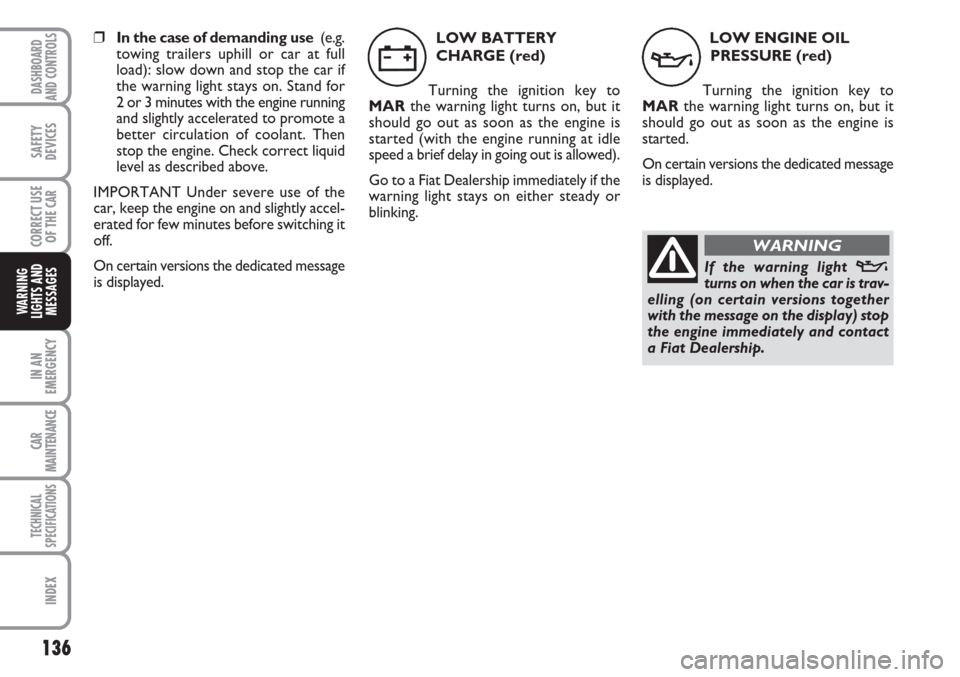
136
IN AN
EMERGENCY
CAR
MAINTENANCE
TECHNICAL
SPECIFICATIONS
INDEX
DASHBOARD
AND CONTROLS
SAFETY
DEVICES
CORRECT USE
OF THE
CAR
WARNING
LIGHTS AND
MESSAGES
LOW ENGINE OIL
PRESSURE (red)
Turning the ignition key to
MARthe warning light turns on, but it
should go out as soon as the engine is
started.
On certain versions the dedicated message
is displayed.
v
If the warning light vturns on when the car is trav-
elling (on certain versions together
with the message on the display) stop
the engine immediately and contact
a Fiat Dealership.
WARNING
❒In the case of demanding use (e.g.
towing trailers uphill or car at full
load): slow down and stop the car if
the warning light stays on. Stand for
2 or 3 minutes with the engine running
and slightly accelerated to promote a
better circulation of coolant. Then
stop the engine. Check correct liquid
level as described above.
IMPORTANT Under severe use of the
car, keep the engine on and slightly accel-
erated for few minutes before switching it
off.
On certain versions the dedicated message
is displayed.LOW BATTERY
CHARGE (red)
Turning the ignition key to
MARthe warning light turns on, but it
should go out as soon as the engine is
started (with the engine running at idle
speed a brief delay in going out is allowed).
Go to a Fiat Dealership immediately if the
warning light stays on either steady or
blinking.
w
Page 139 of 230
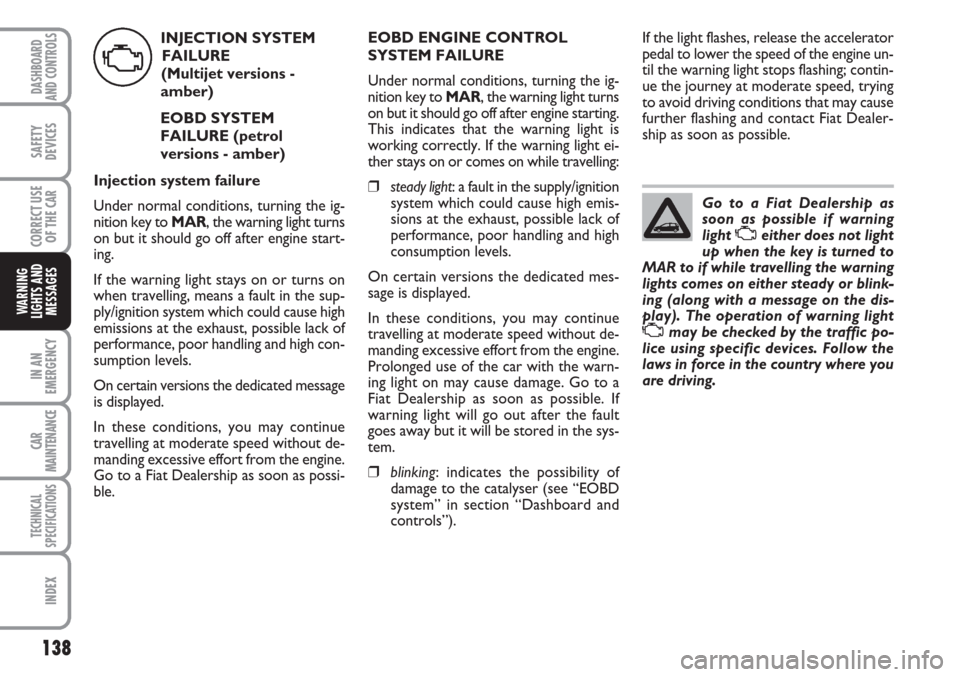
138
IN AN
EMERGENCY
CAR
MAINTENANCE
TECHNICAL
SPECIFICATIONS
INDEX
DASHBOARD
AND CONTROLS
SAFETY
DEVICES
CORRECT USE
OF THE
CAR
WARNING
LIGHTS AND
MESSAGES
Go to a Fiat Dealership as
soon as possible if warning
light
Ueither does not light
up when the key is turned to
MAR to if while travelling the warning
lights comes on either steady or blink-
ing (along with a message on the dis-
play). The operation of warning light
Umay be checked by the traffic po-
lice using specific devices. Follow the
laws in force in the country where you
are driving.
If the light flashes, release the accelerator
pedal to lower the speed of the engine un-
til the warning light stops flashing; contin-
ue the journey at moderate speed, trying
to avoid driving conditions that may cause
further flashing and contact Fiat Dealer-
ship as soon as possible. EOBD ENGINE CONTROL
SYSTEM FAILURE
Under normal conditions, turning the ig-
nition key to MAR, the warning light turns
on but it should go off after engine starting.
This indicates that the warning light is
working correctly. If the warning light ei-
ther stays on or comes on while travelling:
❒steady light: a fault in the supply/ignition
system which could cause high emis-
sions at the exhaust, possible lack of
performance, poor handling and high
consumption levels.
On certain versions the dedicated mes-
sage is displayed.
In these conditions, you may continue
travelling at moderate speed without de-
manding excessive effort from the engine.
Prolonged use of the car with the warn-
ing light on may cause damage. Go to a
Fiat Dealership as soon as possible. If
warning light will go out after the fault
goes away but it will be stored in the sys-
tem.
❒blinking: indicates the possibility of
damage to the catalyser (see “EOBD
system” in section “Dashboard and
controls”). INJECTION SYSTEM
FAILURE
(Multijet versions -
amber)
EOBD SYSTEM
FAILURE (petrol
versions - amber)
Injection system failure
Under normal conditions, turning the ig-
nition key to MAR, the warning light turns
on but it should go off after engine start-
ing.
If the warning light stays on or turns on
when travelling, means a fault in the sup-
ply/ignition system which could cause high
emissions at the exhaust, possible lack of
performance, poor handling and high con-
sumption levels.
On certain versions the dedicated message
is displayed.
In these conditions, you may continue
travelling at moderate speed without de-
manding excessive effort from the engine.
Go to a Fiat Dealership as soon as possi-
ble.
U
Page 157 of 230
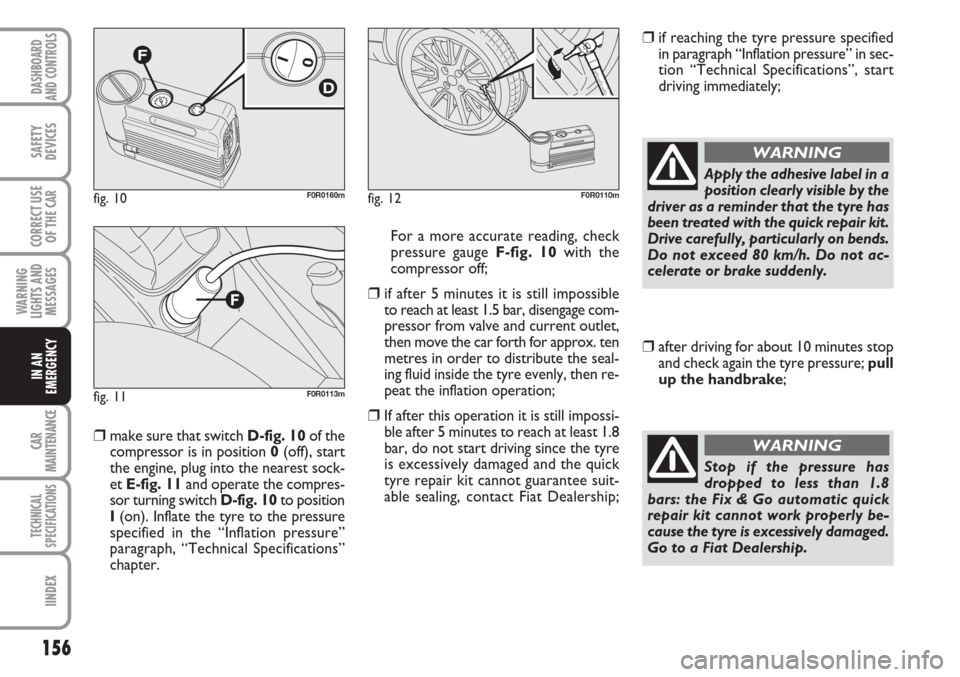
156
WARNING
LIGHTS AND
MESSAGES
CAR
MAINTENANCE
TECHNICAL
SPECIFICATIONS
IINDEX
DASHBOARD
AND CONTROLS
SAFETY
DEVICES
CORRECT USE
OF THE
CAR
IN AN
EMERGENCY
❒make sure that switch D-fig. 10of the
compressor is in position 0(off), start
the engine, plug into the nearest sock-
et E-fig. 11and operate the compres-
sor turning switch D-fig. 10to position
I(on). Inflate the tyre to the pressure
specified in the “Inflation pressure”
paragraph, “Technical Specifications”
chapter. For a more accurate reading, check
pressure gauge F-fig. 10with the
compressor off;
❒if after 5 minutes it is still impossible
to reach at least 1.5 bar, disengage com-
pressor from valve and current outlet,
then move the car forth for approx. ten
metres in order to distribute the seal-
ing fluid inside the tyre evenly, then re-
peat the inflation operation;
❒If after this operation it is still impossi-
ble after 5 minutes to reach at least 1.8
bar, do not start driving since the tyre
is excessively damaged and the quick
tyre repair kit cannot guarantee suit-
able sealing, contact Fiat Dealership;
❒if reaching the tyre pressure specified
in paragraph “Inflation pressure” in sec-
tion “Technical Specifications”, start
driving immediately;
fig. 10F0R0160m
fig. 11F0R0113m
fig. 12F0R0110m
Apply the adhesive label in a
position clearly visible by the
driver as a reminder that the tyre has
been treated with the quick repair kit.
Drive carefully, particularly on bends.
Do not exceed 80 km/h. Do not ac-
celerate or brake suddenly.
WARNING
❒after driving for about 10 minutes stop
and check again the tyre pressure; pull
up the handbrake;
Stop if the pressure has
dropped to less than 1.8
bars: the Fix & Go automatic quick
repair kit cannot work properly be-
cause the tyre is excessively damaged.
Go to a Fiat Dealership.
WARNING
Page 158 of 230
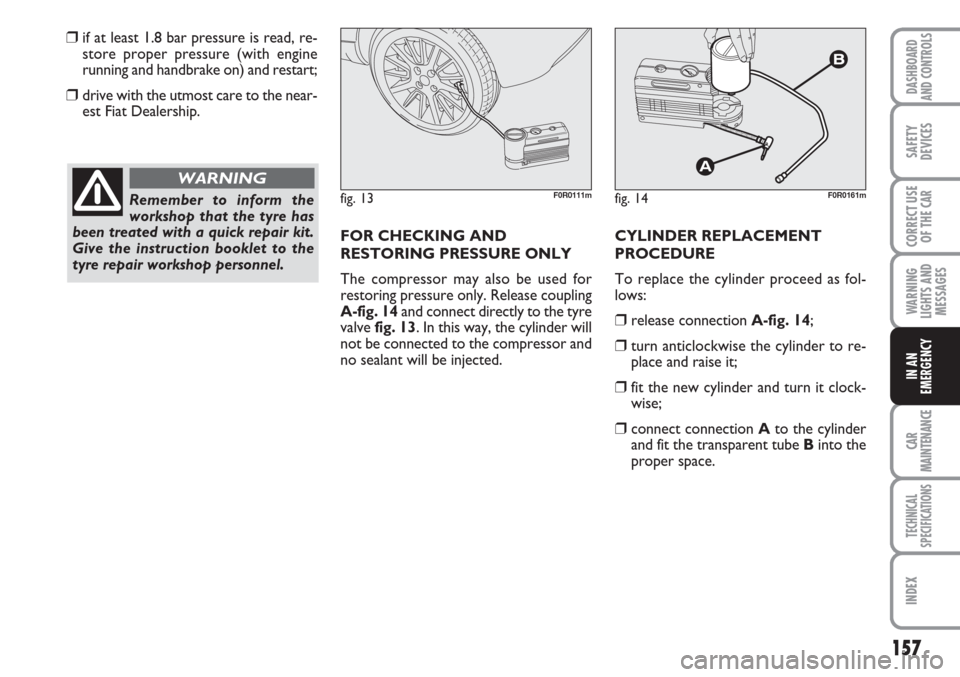
157
WARNING
LIGHTS AND
MESSAGES
CAR
MAINTENANCE
TECHNICAL
SPECIFICATIONS
INDEX
DASHBOARD
AND CONTROLS
SAFETY
DEVICES
CORRECT USE
OF THE
CAR
IN AN
EMERGENCY
❒if at least 1.8 bar pressure is read, re-
store proper pressure (with engine
running and handbrake on) and restart;
❒drive with the utmost care to the near-
est Fiat Dealership.
FOR CHECKING AND
RESTORING PRESSURE ONLY
The compressor may also be used for
restoring pressure only. Release coupling
A-fig. 14and connect directly to the tyre
valve fig. 13. In this way, the cylinder will
not be connected to the compressor and
no sealant will be injected. CYLINDER REPLACEMENT
PROCEDURE
To replace the cylinder proceed as fol-
lows:
❒release connection A-fig. 14;
❒turn anticlockwise the cylinder to re-
place and raise it;
❒fit the new cylinder and turn it clock-
wise;
❒connect connection Ato the cylinder
and fit the transparent tube Binto the
proper space.
Remember to inform the
workshop that the tyre has
been treated with a quick repair kit.
Give the instruction booklet to the
tyre repair workshop personnel.
WARNING
fig. 13F0R0111mfig. 14F0R0161m
Page 181 of 230
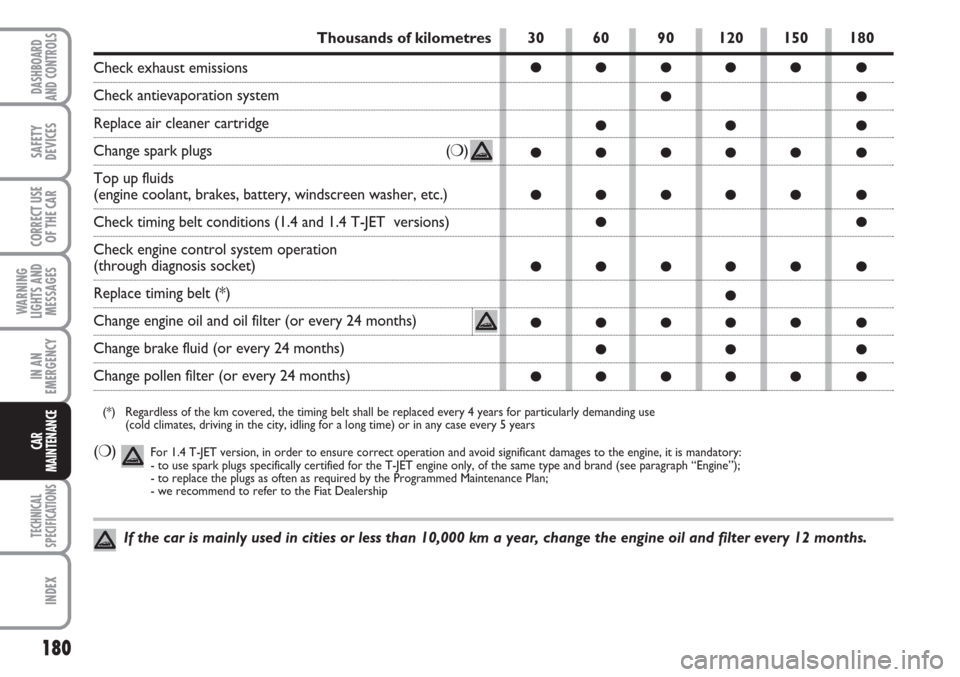
180
WARNING
LIGHTS AND
MESSAGES
TECHNICAL
SPECIFICATIONS
INDEX
DASHBOARD
AND CONTROLS
SAFETY
DEVICES
CORRECT USE
OF THE CAR
IN AN
EMERGENCY
CAR
MAINTENANCE
If the car is mainly used in cities or less than 10,000 km a year, change the engine oil and filter every 12 months.30 60 90 120 150 180
●●●●● ●
●●
●● ●
●●●●● ●
●●●●● ●
●●
●●●●● ●
●
●●●●● ●
●● ●
●●●●● ●
Thousands of kilometres
Check exhaust emissions
Check antievaporation system
Replace air cleaner cartridge
Change spark plugs (❍)
Top up fluids
(engine coolant, brakes, battery, windscreen washer, etc.)
Check timing belt conditions (1.4 and 1.4 T-JET versions)
Check engine control system operation
(through diagnosis socket)
Replace timing belt (*)
Change engine oil and oil filter (or every 24 months)
Change brake fluid (or every 24 months)
Change pollen filter (or every 24 months)
(*) Regardless of the km covered, the timing belt shall be replaced every 4 years for particularly demanding use
(cold climates, driving in the city, idling for a long time) or in any case every 5 years
(❍)For 1.4 T-JET version, in order to ensure correct operation and avoid significant damages to the engine, it is mandatory:
- to use spark plugs specifically certified for the T-JET engine only, of the same type and brand (see paragraph “Engine”);
- to replace the plugs as often as required by the Programmed Maintenance Plan;
- we recommend to refer to the Fiat Dealership
Page 183 of 230
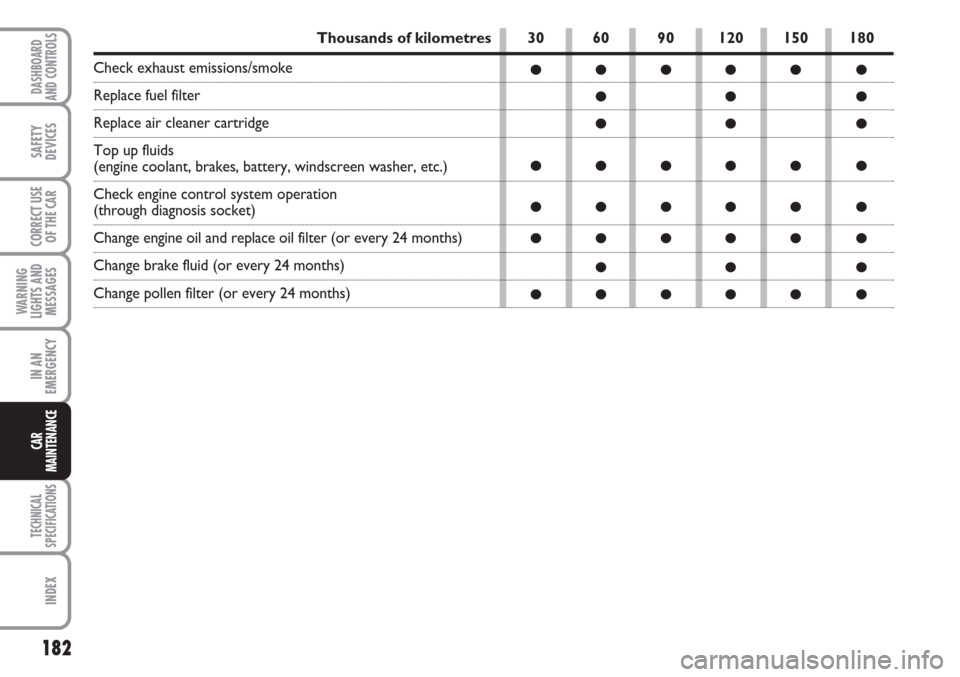
182
WARNING
LIGHTS AND
MESSAGES
TECHNICAL
SPECIFICATIONS
INDEX
DASHBOARD
AND CONTROLS
SAFETY
DEVICES
CORRECT USE
OF THE CAR
IN AN
EMERGENCY
CAR
MAINTENANCE
30 60 90 120 150 180
●●●●● ●
●● ●
●● ●
●●●●● ●
●●●●● ●
●●●●● ●
●● ●
●●●●● ●
Thousands of kilometres
Check exhaust emissions/smoke
Replace fuel filter
Replace air cleaner cartridge
Top up fluids
(engine coolant, brakes, battery, windscreen washer, etc.)
Check engine control system operation
(through diagnosis socket)
Change engine oil and replace oil filter (or every 24 months)
Change brake fluid (or every 24 months)
Change pollen filter (or every 24 months)
Page 184 of 230
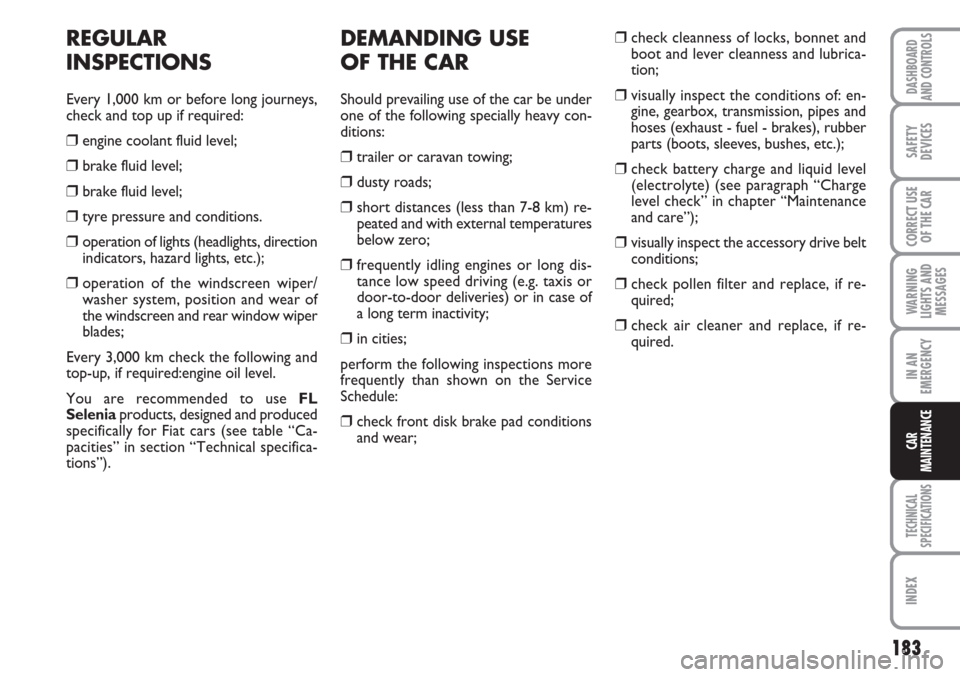
183
WARNING
LIGHTS AND
MESSAGES
TECHNICAL
SPECIFICATIONS
INDEX
DASHBOARD
AND CONTROLS
SAFETY
DEVICES
CORRECT USE
OF THE CAR
IN AN
EMERGENCY
CAR
MAINTENANCE
DEMANDING USE
OF THE CAR
Should prevailing use of the car be under
one of the following specially heavy con-
ditions:
❒trailer or caravan towing;
❒dusty roads;
❒short distances (less than 7-8 km) re-
peated and with external temperatures
below zero;
❒frequently idling engines or long dis-
tance low speed driving (e.g. taxis or
door-to-door deliveries) or in case of
a long term inactivity;
❒in cities;
perform the following inspections more
frequently than shown on the Service
Schedule:
❒check front disk brake pad conditions
and wear;
❒check cleanness of locks, bonnet and
boot and lever cleanness and lubrica-
tion;
❒visually inspect the conditions of: en-
gine, gearbox, transmission, pipes and
hoses (exhaust - fuel - brakes), rubber
parts (boots, sleeves, bushes, etc.);
❒check battery charge and liquid level
(electrolyte) (see paragraph “Charge
level check” in chapter “Maintenance
and care”);
❒visually inspect the accessory drive belt
conditions;
❒check pollen filter and replace, if re-
quired;
❒check air cleaner and replace, if re-
quired.
REGULAR
INSPECTIONS
Every 1,000 km or before long journeys,
check and top up if required:
❒engine coolant fluid level;
❒brake fluid level;
❒brake fluid level;
❒tyre pressure and conditions.
❒operation of lights (headlights, direction
indicators, hazard lights, etc.);
❒operation of the windscreen wiper/
washer system, position and wear of
the windscreen and rear window wiper
blades;
Every 3,000 km check the following and
top-up, if required:engine oil level.
You are recommended to use FL
Seleniaproducts, designed and produced
specifically for Fiat cars (see table “Ca-
pacities” in section “Technical specifica-
tions”).
Page 185 of 230
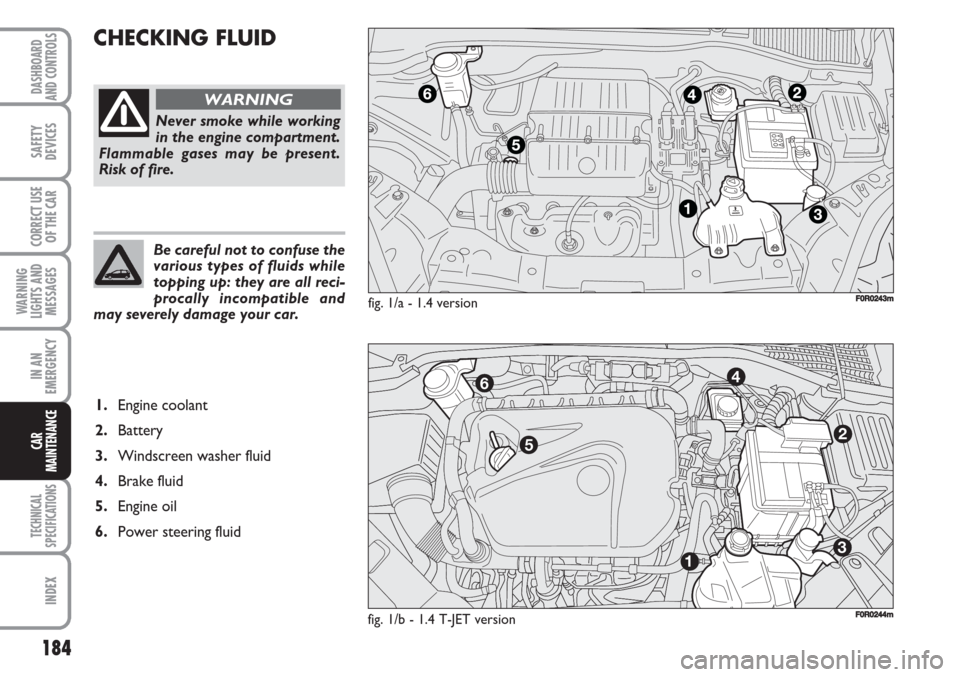
184
WARNING
LIGHTS AND
MESSAGES
TECHNICAL
SPECIFICATIONS
INDEX
DASHBOARD
AND CONTROLS
SAFETY
DEVICES
CORRECT USE
OF THE CAR
IN AN
EMERGENCY
CAR
MAINTENANCE
CHECKING FLUID
fig. 1/a - 1.4 version
Never smoke while working
in the engine compartment.
Flammable gases may be present.
Risk of fire.
WARNING
Be careful not to confuse the
various types of fluids while
topping up: they are all reci-
procally incompatible and
may severely damage your car.
F0R0243m
1.Engine coolant
2.Battery
3.Windscreen washer fluid
4.Brake fluid
5.Engine oil
6.Power steering fluid
fig. 1/b - 1.4 T-JET version
2
64
5
13
2
64
5
13
2
64
5
13
F0R0244m
Page 187 of 230
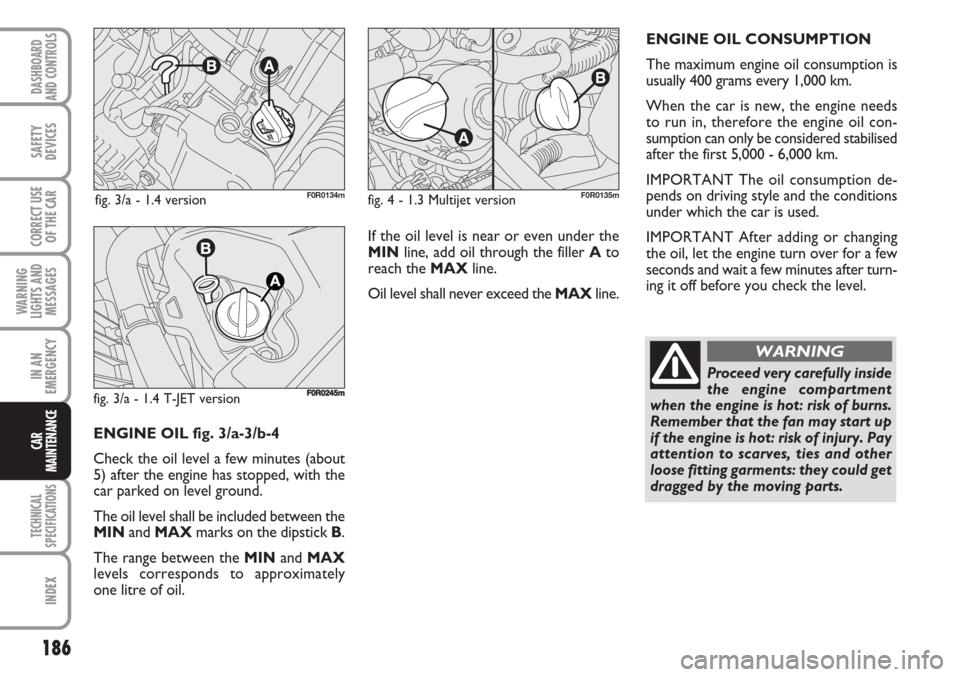
186
WARNING
LIGHTS AND
MESSAGES
TECHNICAL
SPECIFICATIONS
INDEX
DASHBOARD
AND CONTROLS
SAFETY
DEVICES
CORRECT USE
OF THE CAR
IN AN
EMERGENCY
CAR
MAINTENANCE
If the oil level is near or even under the
MINline, add oil through the filler Ato
reach the MAXline.
Oil level shall never exceed the MAXline.ENGINE OIL CONSUMPTION
The maximum engine oil consumption is
usually 400 grams every 1,000 km.
When the car is new, the engine needs
to run in, therefore the engine oil con-
sumption can only be considered stabilised
after the first 5,000 - 6,000 km.
IMPORTANT The oil consumption de-
pends on driving style and the conditions
under which the car is used.
IMPORTANT After adding or changing
the oil, let the engine turn over for a few
seconds and wait a few minutes after turn-
ing it off before you check the level.
ENGINE OIL fig. 3/a-3/b-4
Check the oil level a few minutes (about
5) after the engine has stopped, with the
car parked on level ground.
The oil level shall be included between the
MINand MAXmarks on the dipstick B.
The range between the MINand MAX
levels corresponds to approximately
one litre of oil.
fig. 3/a - 1.4 version F0R0134mfig. 4 - 1.3 Multijet versionF0R0135m
Proceed very carefully inside
the engine compartment
when the engine is hot: risk of burns.
Remember that the fan may start up
if the engine is hot: risk of injury. Pay
attention to scarves, ties and other
loose fitting garments: they could get
dragged by the moving parts.
WARNING
fig. 3/a - 1.4 T-JET versionF0R0245m
Page 188 of 230
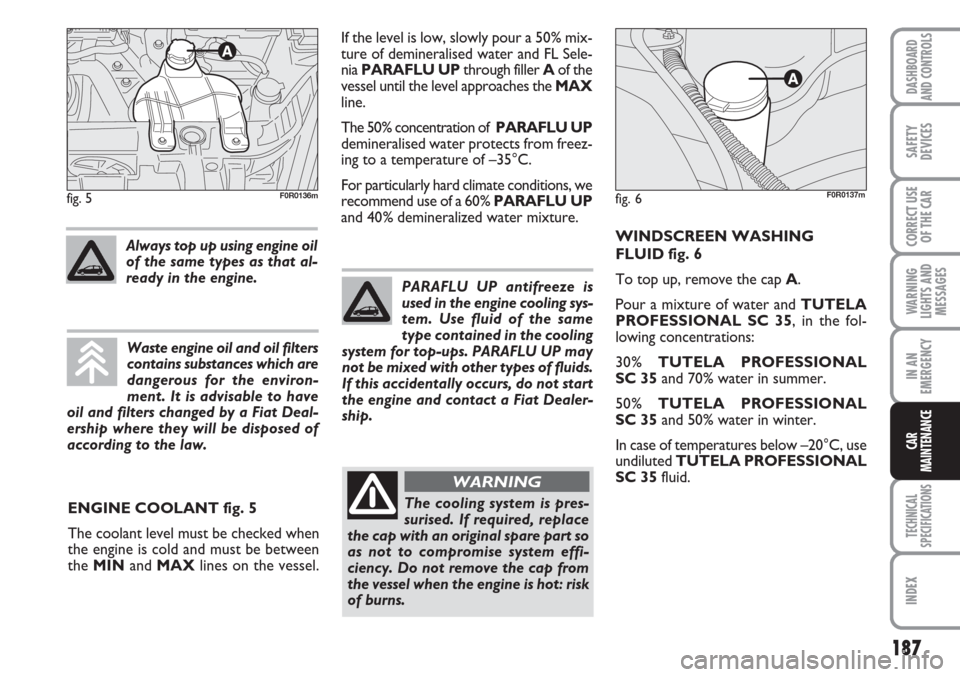
187
WARNING
LIGHTS AND
MESSAGES
TECHNICAL
SPECIFICATIONS
INDEX
DASHBOARD
AND CONTROLS
SAFETY
DEVICES
CORRECT USE
OF THE CAR
IN AN
EMERGENCY
CAR
MAINTENANCE
WINDSCREEN WASHING
FLUID fig. 6
To top up, remove the cap A.
Pour a mixture of water and TUTELA
PROFESSIONAL SC 35, in the fol-
lowing concentrations:
30% TUTELA PROFESSIONAL
SC 35and 70% water in summer.
50% TUTELA PROFESSIONAL
SC 35and 50% water in winter.
In case of temperatures below –20°C, use
undiluted TUTELA PROFESSIONAL
SC 35fluid.
ENGINE COOLANT fig. 5
The coolant level must be checked when
the engine is cold and must be between
the MINand MAXlines on the vessel.
fig. 5F0R0136mfig. 6
PARAFLU UP antifreeze is
used in the engine cooling sys-
tem. Use fluid of the same
type contained in the cooling
system for top-ups. PARAFLU UP may
not be mixed with other types of fluids.
If this accidentally occurs, do not start
the engine and contact a Fiat Dealer-
ship.
The cooling system is pres-
surised. If required, replace
the cap with an original spare part so
as not to compromise system effi-
ciency. Do not remove the cap from
the vessel when the engine is hot: risk
of burns.
WARNING
F0R0137m
If the level is low, slowly pour a 50% mix-
ture of demineralised water and FL Sele-
nia PARAFLU UPthrough filler Aof the
vessel until the level approaches the MAX
line.
The 50% concentration of PARAFLU UP
demineralised water protects from freez-
ing to a temperature of –35°C.
For particularly hard climate conditions, we
recommend use of a 60% PARAFLU UP
and 40% demineralized water mixture.
Waste engine oil and oil filters
contains substances which are
dangerous for the environ-
ment. It is advisable to have
oil and filters changed by a Fiat Deal-
ership where they will be disposed of
according to the law.
Always top up using engine oil
of the same types as that al-
ready in the engine.